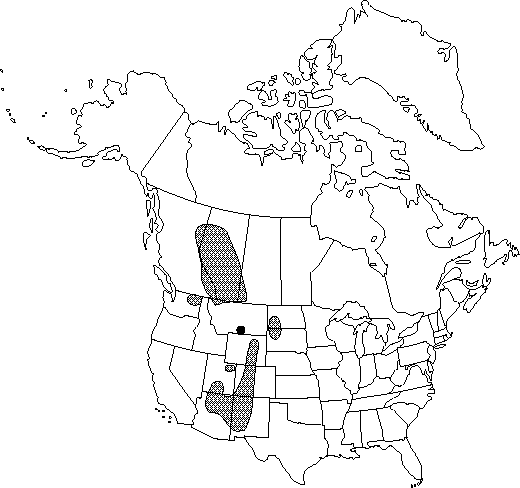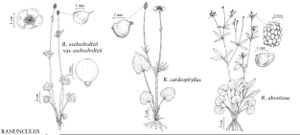Difference between revisions of "Ranunculus cardiophyllus"
Fl. Bor.-Amer. 1: 14. 1829.
FNA>Volume Importer |
imported>Volume Importer |
||
| (7 intermediate revisions by 2 users not shown) | |||
| Line 13: | Line 13: | ||
}}{{Treatment/ID/Special_status | }}{{Treatment/ID/Special_status | ||
|code=F | |code=F | ||
| − | |label= | + | |label=Illustrated |
}} | }} | ||
|basionyms= | |basionyms= | ||
|synonyms={{Treatment/ID/Synonym | |synonyms={{Treatment/ID/Synonym | ||
| − | |name= | + | |name=Ranunculus cardiophyllus var. coloradensis |
|authority=L. D. Benson | |authority=L. D. Benson | ||
| − | }}{{Treatment/ID/Synonym | + | |rank=variety |
| − | |name= | + | }} {{Treatment/ID/Synonym |
| + | |name=Ranunculus cardiophyllus var. subsagittatus | ||
|authority=(A. Gray) L. D. Benson | |authority=(A. Gray) L. D. Benson | ||
| − | }}{{Treatment/ID/Synonym | + | |rank=variety |
| − | |name= | + | }} {{Treatment/ID/Synonym |
| + | |name=Ranunculus pedatifidus var. cardiophyllus | ||
|authority=(Hooker) Britton | |authority=(Hooker) Britton | ||
| + | |rank=variety | ||
}} | }} | ||
|hierarchy=Ranunculaceae;Ranunculus;Ranunculus subg. Ranunculus;Ranunculus sect. Epirotes;Ranunculus cardiophyllus | |hierarchy=Ranunculaceae;Ranunculus;Ranunculus subg. Ranunculus;Ranunculus sect. Epirotes;Ranunculus cardiophyllus | ||
| Line 33: | Line 36: | ||
}}<!-- | }}<!-- | ||
| − | --><span class="statement" id="st- | + | --><span class="statement" id="st-undefined" data-properties=""><b>Stems </b>erect, 11-53 cm, pilose or glabrous, each with 1-5 flowers. <b>Roots</b> cylindric, 1.3-2 mm thick. <b>Basal</b> leaves persistent, blades ovate or elliptic, undivided or innermost 3-5-parted, 2.2-6.9 × 1.8-4.5 cm, base cordate to broadly obtuse, margins crenate with more than 5 crenae, apex rounded to broadly acute. <b>Flowers</b>: pedicels pilose; receptacle canescent; sepals 5-8 × 3-7 mm, abaxially pilose, hairs colorless; petals (0-)5-10, 6-13 × 4-13 mm; nectary scale ciliate or sometimes glabrous. <b>Heads</b> of achenes ovoid or cylindric, 5-16 × 5-9 mm; achenes 1.8-2.2 × 1.5-2 mm, finely canescent; beak subulate, curved or straight, 0.6-1.2 mm. <b>2n</b> = 32.</span><!-- |
-->{{Treatment/Body | -->{{Treatment/Body | ||
| Line 40: | Line 43: | ||
|elevation=600-3400 m | |elevation=600-3400 m | ||
|distribution=Alta.;B.C.;Sask.;Ariz.;Colo.;Mont.;N.Mex.;N.Dak.;S.Dak.;Utah;Wash.;Wyo. | |distribution=Alta.;B.C.;Sask.;Ariz.;Colo.;Mont.;N.Mex.;N.Dak.;S.Dak.;Utah;Wash.;Wyo. | ||
| − | |discussion=<p>Ranunculus cardiophyllus is quite variable. Through most of its range, leaves always have rounded marginal crenae and cordate or truncate bases, stems are often densely pilose (but may be sparsely pilose or glabrous), and achene beaks are curved. In plants from Arizona and New Mexico, however, leaves may have obtuse marginal crenae or broadly obtuse bases, stems are never densely pilose, and achene beaks are sometimes straight. Forms showing some or all of these charactersistics are often separated as R. cardiophyllus var. subsagittatus. The characteristics are poorly correlated, however, and taxonomic recognition is not warranted.</p><!-- | + | |discussion=<p><i>Ranunculus cardiophyllus</i> is quite variable. Through most of its range, leaves always have rounded marginal crenae and cordate or truncate bases, stems are often densely pilose (but may be sparsely pilose or glabrous), and achene beaks are curved. In plants from Arizona and New Mexico, however, leaves may have obtuse marginal crenae or broadly obtuse bases, stems are never densely pilose, and achene beaks are sometimes straight. Forms showing some or all of these charactersistics are often separated as <i>R. cardiophyllus</i> var. subsagittatus. The characteristics are poorly correlated, however, and taxonomic recognition is not warranted.</p><!-- |
| − | --><p>Most specimens of Ranunculus cardiophyllus have all of the basal leaves unlobed, but plants with the innermost basal leaf 3-5-lobed are common. A few specimens, mostly from the northern part of its range, have all of the basal leaves 5-parted or -divided. Those plants approach R. pedatifidus in their morphology, and R. cardiophyllus has sometimes been considered a variety of that species.</p> | + | --><p>Most specimens of <i>Ranunculus cardiophyllus</i> have all of the basal leaves unlobed, but plants with the innermost basal leaf 3-5-lobed are common. A few specimens, mostly from the northern part of its range, have all of the basal leaves 5-parted or -divided. Those plants approach <i>R. pedatifidus</i> in their morphology, and <i>R. cardiophyllus</i> has sometimes been considered a variety of that species.</p> |
|tables= | |tables= | ||
|references= | |references= | ||
| Line 50: | Line 53: | ||
-->{{#Taxon: | -->{{#Taxon: | ||
name=Ranunculus cardiophyllus | name=Ranunculus cardiophyllus | ||
| − | |||
|authority=Hooker | |authority=Hooker | ||
|rank=species | |rank=species | ||
|parent rank=section | |parent rank=section | ||
| − | |synonyms= | + | |synonyms=Ranunculus cardiophyllus var. coloradensis;Ranunculus cardiophyllus var. subsagittatus;Ranunculus pedatifidus var. cardiophyllus |
|basionyms= | |basionyms= | ||
|family=Ranunculaceae | |family=Ranunculaceae | ||
| Line 64: | Line 66: | ||
|publication title=Fl. Bor.-Amer. | |publication title=Fl. Bor.-Amer. | ||
|publication year=1829 | |publication year=1829 | ||
| − | |special status=Endemic; | + | |special status=Endemic;Illustrated |
| − | |source xml=https:// | + | |source xml=https://bitbucket.org/aafc-mbb/fna-data-curation/src/2e0870ddd59836b60bcf96646a41e87ea5a5943a/coarse_grained_fna_xml/V3/V3_68.xml |
|genus=Ranunculus | |genus=Ranunculus | ||
|subgenus=Ranunculus subg. Ranunculus | |subgenus=Ranunculus subg. Ranunculus | ||
|section=Ranunculus sect. Epirotes | |section=Ranunculus sect. Epirotes | ||
|species=Ranunculus cardiophyllus | |species=Ranunculus cardiophyllus | ||
| − | |||
| − | |||
| − | |||
| − | |||
| − | |||
| − | |||
| − | |||
| − | |||
| − | |||
| − | |||
| − | |||
| − | |||
| − | |||
| − | |||
| − | |||
| − | |||
| − | |||
| − | |||
| − | |||
| − | |||
| − | |||
| − | |||
| − | |||
| − | |||
| − | |||
| − | |||
| − | |||
| − | |||
| − | |||
| − | |||
| − | |||
| − | |||
| − | |||
| − | |||
| − | |||
| − | |||
| − | |||
}}<!-- | }}<!-- | ||
-->[[Category:Treatment]][[Category:Ranunculus sect. Epirotes]] | -->[[Category:Treatment]][[Category:Ranunculus sect. Epirotes]] | ||
Latest revision as of 21:50, 5 November 2020
Stems erect, 11-53 cm, pilose or glabrous, each with 1-5 flowers. Roots cylindric, 1.3-2 mm thick. Basal leaves persistent, blades ovate or elliptic, undivided or innermost 3-5-parted, 2.2-6.9 × 1.8-4.5 cm, base cordate to broadly obtuse, margins crenate with more than 5 crenae, apex rounded to broadly acute. Flowers: pedicels pilose; receptacle canescent; sepals 5-8 × 3-7 mm, abaxially pilose, hairs colorless; petals (0-)5-10, 6-13 × 4-13 mm; nectary scale ciliate or sometimes glabrous. Heads of achenes ovoid or cylindric, 5-16 × 5-9 mm; achenes 1.8-2.2 × 1.5-2 mm, finely canescent; beak subulate, curved or straight, 0.6-1.2 mm. 2n = 32.
Phenology: Flowering spring–summer (May–Sep).
Habitat: Wet or dry meadows
Elevation: 600-3400 m
Distribution

Alta., B.C., Sask., Ariz., Colo., Mont., N.Mex., N.Dak., S.Dak., Utah, Wash., Wyo.
Discussion
Ranunculus cardiophyllus is quite variable. Through most of its range, leaves always have rounded marginal crenae and cordate or truncate bases, stems are often densely pilose (but may be sparsely pilose or glabrous), and achene beaks are curved. In plants from Arizona and New Mexico, however, leaves may have obtuse marginal crenae or broadly obtuse bases, stems are never densely pilose, and achene beaks are sometimes straight. Forms showing some or all of these charactersistics are often separated as R. cardiophyllus var. subsagittatus. The characteristics are poorly correlated, however, and taxonomic recognition is not warranted.
Most specimens of Ranunculus cardiophyllus have all of the basal leaves unlobed, but plants with the innermost basal leaf 3-5-lobed are common. A few specimens, mostly from the northern part of its range, have all of the basal leaves 5-parted or -divided. Those plants approach R. pedatifidus in their morphology, and R. cardiophyllus has sometimes been considered a variety of that species.
Selected References
None.
